|
|
Timer circuit. Phase #3: TMR0 as time base |
TMR0 peripheral application as timer
| 1. Specifications | Planning | Dev. & test | Prototype | report | Annex |
Design phase #3: Design a fixed-time timer (for instance TP = 18.5 s) as represented in Fig. 1 replacing the internal RAM variable acting as a datapath counter by the TMR0 running as a time base TB = 4·TOSC = 500 ns. Let us consider the FOSC = 8 MHz crystal oscillator running the PIC18F46K22 µC on the CSD_PICstick board.
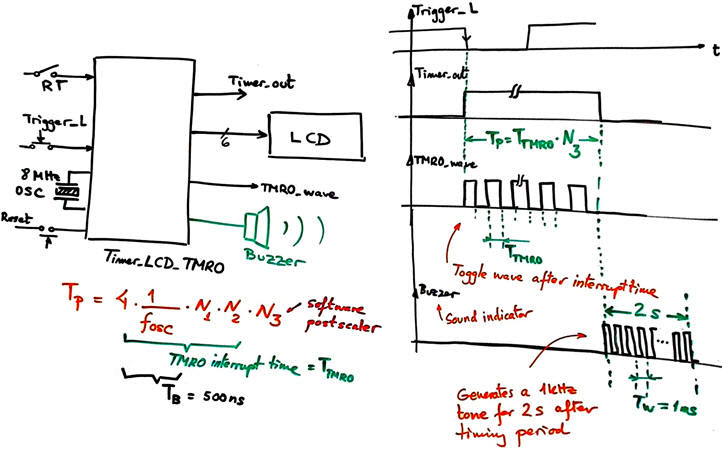 |
|
| Fig. 1. Project entity is the same in phase #2 eliminating the external CLK and replacing it by the internal TMR0. The quartz crystal that is used for running the µC will also determine time accuracy for this application. |
|
Common features:
- The same inherited features from project phase #1 Timer and phase #2 Timer_LCD.
- TMR0 peripheral to generate from the TB = 500 ns a square output signal TMR0_wave with a period 2·TTMR0. (the waveform will toggle every TMR0 interrupt time).
- Optional: Add a buzzer that will sound for 2 s at 1 kHz toneonceethe timing period has ended.the timing period has ended.
Questions:
- Measure simulator's "real-time" using break points and step mode.
- Watch variables of interest.
- Modify parameters to generate TP = 2.23 s.
- Modify parameters to generate TP = 5.00 s when XTAL OSC is 12 MHz.
- Implement the circuit in the CSD_PICstick as a prototype and perform measurements to characterise the circuit's performance.
| Specifications | 2. Planning | Dev. & test | Prototype | report | Annex |
A) Planning hardware
The schematic is simpler from phase #2 because CLK is removed. However, the TMR0 peripheral hardware is included in the project and it has to be configured correctly as our datapath for counting time. As shown in Fig. 2, we can use port pins connected to the CSD_PICstick available resources.
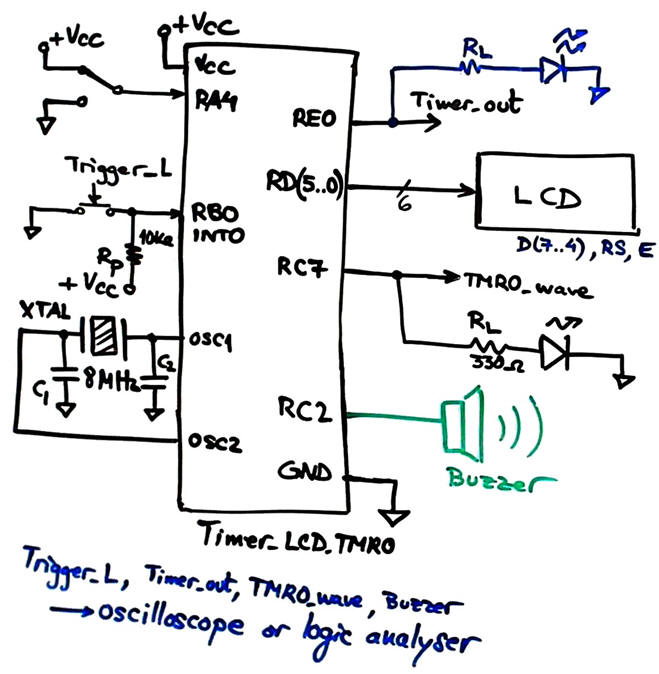  |
Fig. 2. Hardware schematic for the top timer application and also the TMR0 peripheral hardware to configure. |
B) Planning software
Study how the TMR0 works. Hardware configuration bits and registers: CLK edge, CLK source, prescaler selection, TMR0 in 8-bit or 16 bit mode, hardware interrupt on overflow (terminal count) TMR0IF and RAM variable var_TMR0_flag.
The datapath capable of counting real-time is the TMR0 peripheral configured as a timer; the control unit is a FSM running in the main loop. Draw the hardware-software diagram as in Fig. 3 and discuss it.
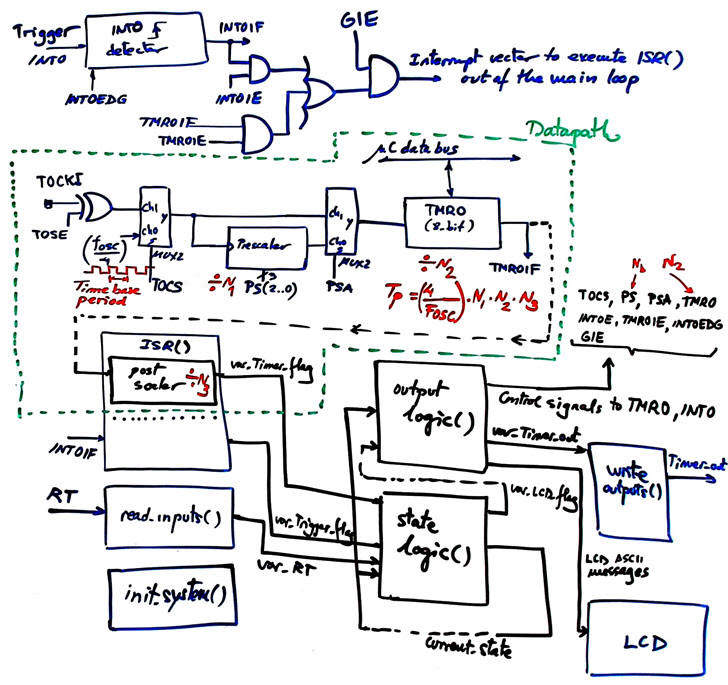 |
Fig. 3. Hardware-software diagram representing in dotted green lines the circuit that has become the datapath for calculating real-time from an internal time-base derived from system OSC. |
Explain the diagram of the TMR0 timer.
Design equation using the prescaler (N1), counter TMR0 (N2), and (software) postscaler (N3) when required:
TP = TB · N1 · N2 · N3 = TTMR0·N3
How to increase counting capacity to any arbitrary large timing period?
Fig. 4 shows how the state diagram may be adapted to generate timing periods using TMR0.
 |
Fig. 4. State diagram for the FSM. |
Program init_system() function configuring ports, interrupts and the TMR0.
 |
Fig. 5. TRIS registers. |
Discuss the state-logic() truth table and flowchart.
 |
Fig. 6. state_logic(). |
Discuss the output-logic() truth table and flowchart.
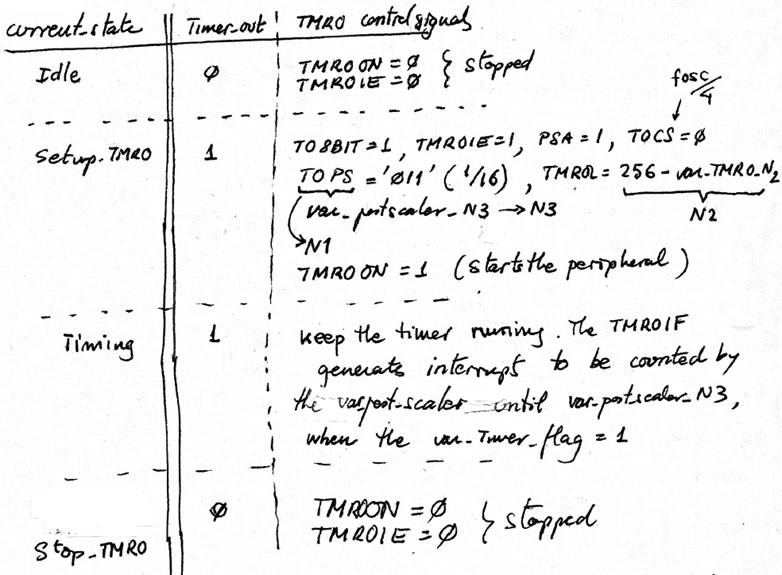 |
Fig. 7. Truth table for the output_logic() representing the instructions to the datapath and outputs. (update picture) |
Program ISR() to acknowledge interrupts from TMR0 and INT0 solving as well the datapath operation of real-time counting.
 |
Fig. 8. ISR().(update picture) |
Program read_inputs(), write_outputs() as in phase #2 or phase #1.
Project location:
C:\CSD\P12\Timer_LCD_TMR0\(files)
| Specifications | Planning | 3. Dev. & 4. test | Prototype | report | Annex |
A) Developing hardware
This is the "Timer_LCD_TMR0.pdsprj" hardware including the LCD and the TMR0.
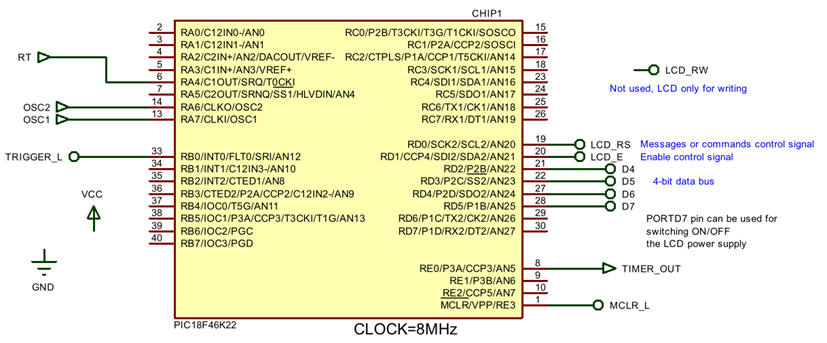 |
| Fig. 8. The variable var_Timer_flag is derived from the internal TMR0. Therefore, the external pin RB1/INT1 is freed and can be used for another purpose. |
B) Developing software
These LCD library files "lcd.c", "lcd.h" has to be included in the project. The file "config.h" contains all the microcontroller configuration bits. This is the example software source code "Timer_LCD_TMR0.c". Generate the executable (*.hex) and debugging file (*.cof) for Proteus simulations.
C) Step-by-step testing
The idea is, as usual, write and run a bit of code with both windows, the hardware Proteus environment and the software MPLABX IDE running simultaneously for easy debugging. Use the watch window and break points to control the program sequence and monitor RAM variables of interest for each function.
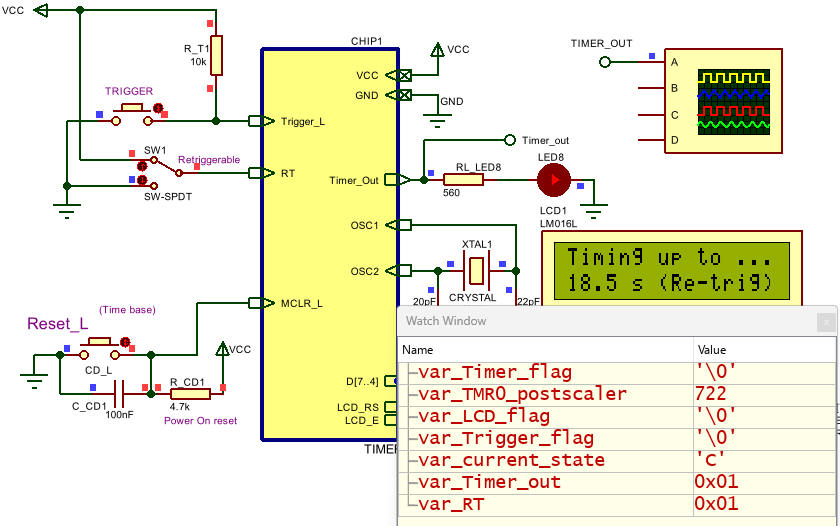 |
| Fig. 9. Circuit running and watching variables of interest. |
We can measure with the Proteus oscilloscope the circuit performance, for instance N3 = 125 generates a TP = 0.5 s, as shown in Fig. 10.
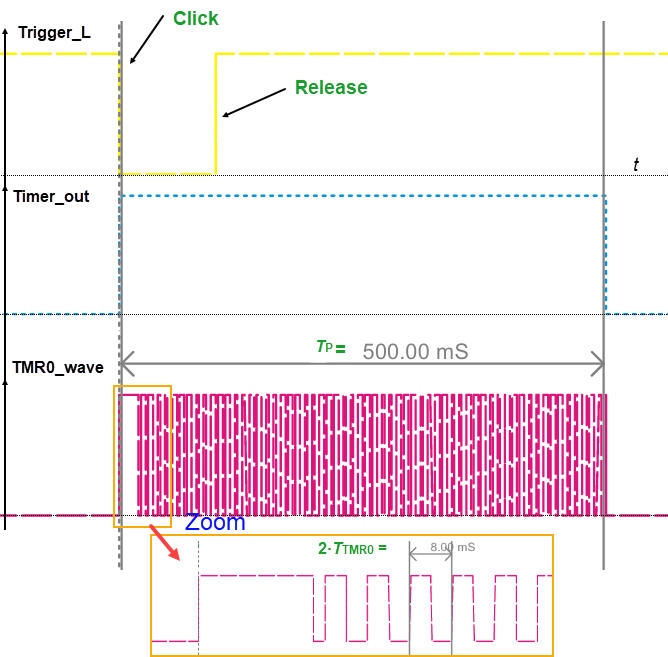 |
| Fig. 10. Waveforms printed from the Proteus oscilloscope. Once the trigger interrupt is generated, we can observe, zooming the TMR0_wave, how TMR0IF is asserted every TTMR0 = 4 ms. |
| Specifications | Planning | Dev. & Test | 5. Prototype | Report | Annex |
Board CSD_PICstick . Target microcontroller: PIC18F46K22. Tools: MPLAB X + XC8 + Proteus + VB8012 compact instrumentation.
Experiment #1: Run the application and visualise results using the board resources. This is for checking the installation of the tools and programming environment.
You will repeat the procedure described in the last LAB10.
Experiment #2 (optional): Download and program the target chip (*.elf) to use the in-circuit debugger. Watch RAM variables in MPLABX IDE. Add breakpoints and follow the program execution as we did in Proteus simulations.
Experiment #3: Visualise digital signals using instruments.
Fig, 13 shows the connections to theVB8012 using the 40-pin header.
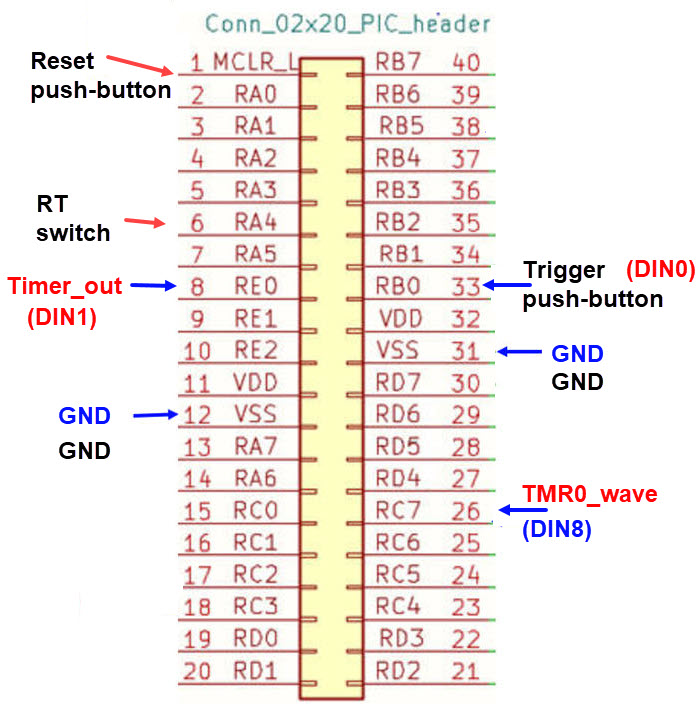 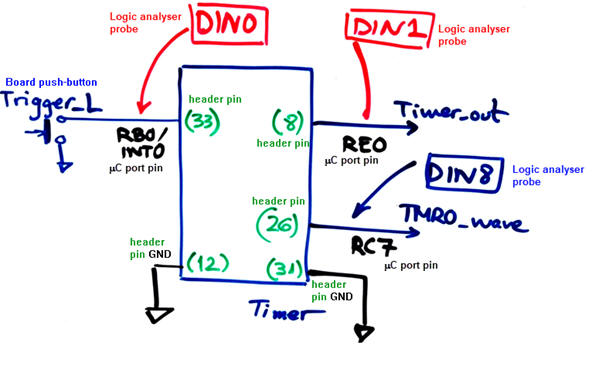 |
Fig. 13. 40-pin header connections to the protoboard and the VB8012. And yet another schematic symbol indicating signals of interest, header pin numbers and instrument probes in different colours. When experimenting in the laboratory, it is crucial to put all your senses in the circuit to avoid short-circuits and other costly hazards. |
In a first step, as shown in Fig. 14, we connect GND, VCC and the LCD contrast potentiometer. Connect the LCD backlight LED to A = +Vcc and K = GND.
 |
Fig. 14. Protoboard short connections to power rails and potentiometer wiring. We use a an electrolytic capacitor as a buffer for energy storage; be aware of its polarity. |
Now we have to verify that these simple connections are right and the breadboard is correctly powered. When experimenting in the laboratory, it is crucial to put all your senses in the circuit to avoid short-circuits and other costly hazards. Attach the 40-pin flat cable adapter and plug the LCD male header to the indicated location. Power on the CSD_PICstick to run again the experiment #1. The Timer_out signal is replicated from the expansion connector pin 8 (RE0).
 |
Fig. 15. Running the experiment #1 with the expansion connector plugged to the breadboard. We also insert the LCD to check whether it is c correctly powered. |
When this first step works correctly, switch off the CSD_PICstick DC power adapter and unplug the cable adapter and the LCD to continue.
In a second step, as shown in Fig. 16, we use 20 cm male-male flexible wires for facilitating the connections to the 6-wire LCD parallel interface bus. And we also connect the long male header pins for the logic analyser probes DIN0 - Trigger_L, DIN15 - Timer_out, DIN16 - TMR0_wave through male headers.
 |
Fig. 16. Flexible wires for interfacing the LCD and the instrument probes by means of long male header pins. |
Now we have to verify that these new connections are right. Attach the 40-pin flat cable adapter and plug the LCD male header to the indicated location. Power on the CSD_PICstick to run again the experiment as shown in Fig. 17. The LCD will display messages and clicking Trigger_L will generate the configured timing periods TP.
 |
Fig. 17. Flexible wires for interfacing the LCD and the instrument probes by means of long male header pins. |
In a third step, as shown in Fig. 18, we complete the setup attaching the instrument probes.
 |
Fig. 18. The final circuit for measuring signals and experimenting. |
Experiment with the full circuit, capture the waveforms and measure the circuit parameters. This is an example of VB8012 setup: "VB8012_setup_Timer_LCD_TMR0.dwf3work".
Capture and comment screens of interest for your reports as shown in Fig. 19.
 |
Fig. 19. Printing and annotating the captured logic analyser waveforms. In this example, it is displayed a timing period TP = 0.5 s (N3 = 125). |
Similar measurements for TP = 1.32 s (N3 = 330).
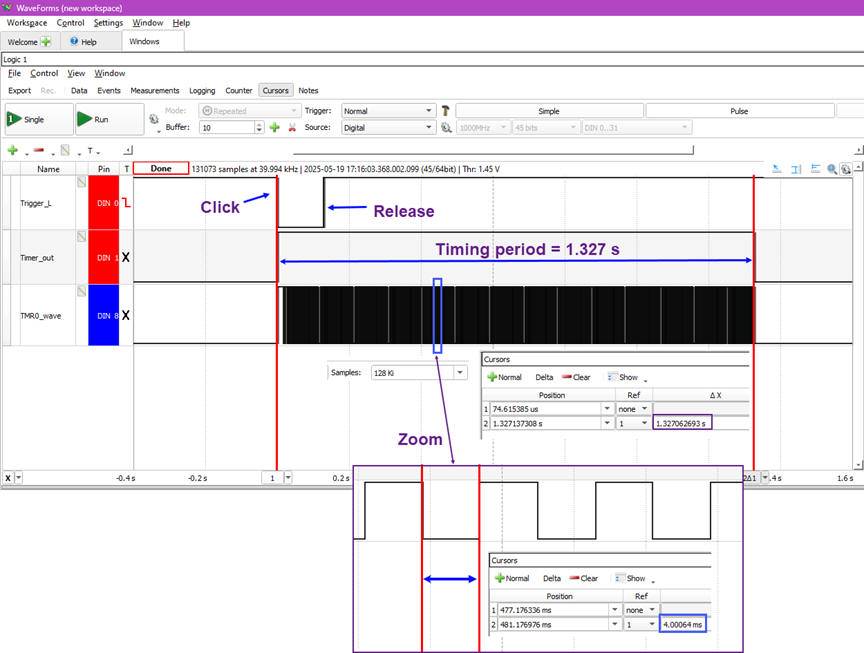 |
Fig. 20. Printing and annotating the captured logic analyser waveforms. We can also zoom into a particular time slot for measuring correctly the half period of the Wave_out signal TTMR0 = 4 ms. |
Once the experiment completed, it is time to look further into details using the MPLAB SNAP in-circuit debugger (experiment #2).
It is also time to enhance the product features. For instance, study how to modify the system to add a buzzer to sound an alarm with a 1 kHz tone for 2 s when the timing period has finished.
If more precision is required, TMR2 can be used instead of TMR0 as proposed in this design phase #4: Timer_LCD_TMR2.
| Specifications | Planning | Dev. & Test | Prototype | 6. Report | Annex |
Follow this rubric for writing reports.
Annex: Example on how to print dynamic data on the LCD |
Specifications
We can enhance the software to represent the count down on the LCD as dynamic data, as it is typical for commercial timers. For instance, let's visualise a time resolution of a tenth of a second while counting down.
Planning
This processing is solved in Timing state (Fig. A1). To solve this problem, we consider to print on the display a new variable var_Count_down = var_TP - var_Current_time calculated every 0.1 s (0.1 s = 25 * TTMR0).
Overflow hardware interrupts from TMR0 occur every TTMR0 = 4 ms, therefore, we need to count 25 interrupts to set the var_LCD_flag to refresh the screen with the updated value var_Count_down.
 |
| Fig. A1. Displaying "real-time" in one-tenth of a second resolution on the LCD. |
Project location:
C:\CSD\P12\Timer_LCD_TMR0_Dyn\(files)
Development and testing
The modified Timer_LCD_TMR0.c solved using float type variables.
 |
Fig. A2. Picture of the timer representing and updating time every tenth of a second. |
Note: When dragging and dropping floating point variables to the watch window they appear as "unspecified".
 |
Fig. A3. |
You can solve this problem in this way:
1) Edit the PIC18F46K22 component properties as a text to add this new property: {{DT_FLOAT=MICROCHIP_BIGENDIAN}
 |
Fig. A4. |
2) When running in step by step mode, select the variable and change its type to IEEE Double (8 bytes):
 |
Fig. A5. |
And, select another time and tick "Big Endian"
 |
Fig. A6. |
In this way, when running you have to be able to monitor the floating point values correctly:
 |
Fig. A7. |
Discussion and measurements:
- Compare the memory occupation when using LCD and sprintf functions. (a) printing only static data. (b) printing dynamic data. Why such large increase on RAM and ROM space?
a)
b)
- The implementation is based on floating point operations using seconds as units TB = 1e-7 s). How to do it using long int type (uint32_tem>) and µs as time base (TB = 0.5 µs · N1 = 16 µs).
- Measure the timing period precision. Is is better or worse that the circuit representing only static data on the display? How long does it take to refresh the dynamic data on the screen every 100 ms?
- Visualise the waveforms, monitor TMR0_wave. Is is a good idea to use the LCD for printing fast dynamic data? Which may be an efficient alternative?


